From a bright day in the lake district to the clouded Scottish highlands, British landscape paintings can be diverse in their visual tone, often capturing idyllic conditions that inspire the imagination or memories of home. This precise and often clear style makes any distraction – such as tears, scratches, stains or overall discolouration – a devastating interruption to what was an immortalised perfect view.
 Above: before and after the restoration of a small landscape painting and gilded frame by our conservation team
Above: before and after the restoration of a small landscape painting and gilded frame by our conservation team
Whilst many continental artists flourished in the realms of portraiture and grandiose mythological scenes, it was native painters who captured the spirit of the British landscape. Influential artists such as Constable and Gainsborough elevated the style further, allowing a humble countryside view to become a masterpiece on canvas.
 Above: a detail from a British landscape painting in our studio
Above: a detail from a British landscape painting in our studio
With many traditional landscapes surviving today from the 18th and 19th centuries, oils on canvas or panel may face vulnerabilities due to old age or new environments. In this article, we will look into the history of British landscape art and the famous names you may find behind these beautiful views, plus care tips on how to avoid dangers and the professional restoration results which can be achieved.
 Above: a John Constable landscape before and after restoration in our studio – the surface was discoloured due to old varnish and smoke/nicotine staining
Above: a John Constable landscape before and after restoration in our studio – the surface was discoloured due to old varnish and smoke/nicotine staining
The history of British landscape painting
In western art history, landscapes often struggled to stand as their own genre – instead of pure views of lush vegetation and natural beauty, they were repeatedly seen as a stage to place figurative subjects. This need for an active context was due to the hierarchy of genres in oil painting, which placed emphasis on the creative and most imaginative scenes with heavy literary or biblical themes. To reproduce a view of the countryside was historically seen to come just above still life paintings in artistic complexity and skill.
 Above: a 17th century view of Richmond Castle, Yorkshire by Alexander Keirincx, 1639
Above: a 17th century view of Richmond Castle, Yorkshire by Alexander Keirincx, 1639
This pressure of hierarchy did not put a complete stop to artists practising the art of landscape painting, but it certainly stalled its progress. If skilled landscape artists wanted to further their careers or gain wealthy patrons, they may have felt compelled to place classical stories or allegorical figures within the scene – distracting from the pure natural beauty. Due to this, it was not until the latter half of the 18th century that we can talk about particularly British landscape paintings as a genre in their own right.
 Above: detail from a landscape by Thomas Gainsborough dated to the mid 18th century
Above: detail from a landscape by Thomas Gainsborough dated to the mid 18th century
Thomas Gainsborough had favoured landscapes but had to use the more commercial genre of portraiture to please patrons – he did however include grand pastoral backgrounds and displays of landownership as much as possible in his distinctive, painterly style. The rise of landscape painting as a respected and popular artistic pursuit was partly due to fashion, the rococo period especially favoured pastoral settings. Secondly, wealthy landowners provided a growing demand for capturing newly designed gardens at country manor houses, such as those by Capability Brown, as well as dramatic views of ancestral land.
 Above: a detail from a painting of Knock Ninney and Lough Erne from Bellisle, County Fermanagh, Ireland by Thomas Roberts, 1771
Above: a detail from a painting of Knock Ninney and Lough Erne from Bellisle, County Fermanagh, Ireland by Thomas Roberts, 1771
Landscape painting in Britain painting came into its own by the 19th century – Romanticism took hold and invigorated idyllic notions of natural beauty. This movement also glorified the purity of the past, allowing British landscapes to present themselves as far more than just a reproduction of life but as a symbolic display of untouched beauty. Romanticism arose in contrast to the industrial revolution and rational scientific advancements, it was far more interested in an unconstrained, heavenly view of rural life and landscapes.
 Above: a detail from a John Linnell landscape entitled Evening, Bayswater, 1818
Above: a detail from a John Linnell landscape entitled Evening, Bayswater, 1818
One of the most famous Romantic artists of the period is John Constable. At first, Constable’s artwork was seen as unfashionable due to his focus on rural simplicity rather than dramatic grandeur. His first major success was with The White Horse in 1819, this was the first of his ‘six-footer’ canvases, named due to their large size – The White Horse measures 131.4 x 188.3 centimetres. This large-scale series included his masterpiece The Hay Wain from 1821 which inspired both British and European artists of the era. The sheer popularity of Constable’s rural landscapes means that we often see copies after the originals by later artists, as well as prints of his paintings in homes across the world. As well as The Hay Wain, you may also come across Constable’s The Lock, Stratford Mill and Salisbury Cathedral from the Meadows.
 Above: a detail from an oil sketch by John Constable of his White Horse masterpiece, 1819
Above: a detail from an oil sketch by John Constable of his White Horse masterpiece, 1819
Further famous British landscape artists from the 19th century include:
- J. M. W. Turner
- Samuel Palmer
- Clarkson Stanfield
- William Shayer
- William Frederick Witherington
- David Roberts
- Alfred Vickers
- Joseph William Allen
- William Collins
- William Linton
- Frederick Richard Lee
- George Cole
- John Linnell
- John Martin
 Above: a detail from a view of London from Greenwich Hill by Henry Dawson, 1869
Above: a detail from a view of London from Greenwich Hill by Henry Dawson, 1869
In the early 20th century a more abstract approach to British landscapes emerged as new ideas challenged the limits of what was seen before the artist in nature. Born in 1887, L.S. Lowry captured modern life in Salford and North West England during the turn of the century and later decades, using an impressionistic style to capture a new urban era.
Caring for antique landscape paintings
The perfect atmospheric condition for any painting requires stability, at around 20 degrees celsius and no more than 40% humidity. This will ensure that the environment is not so humid as to encourage mould growth and kept at an even level to avoid the constant expansion and contraction of a canvas or wooden panel. Areas above a heater or radiator should be avoided, as this constant fluctuation may lead to cracking in the paint layer as the surface moves.
 Above: detail from a landscape in our studio with a cracked surface, before restoration to stabilise the painting and lessen the disturbance
Above: detail from a landscape in our studio with a cracked surface, before restoration to stabilise the painting and lessen the disturbance
When moving or transporting the landscape painting, ensure that it is flat, or better still and kept within its frame for extra protection (if possible). Check that all pathways are clear before attempting to move the artwork, always ask for extra help if it is a large piece. If settled on the ground, do not allow the canvas to lean against any corners, avoid pets coming into the same space, and be mindful of any dangerous items that the painting could fall against.
 Above: a dull surface on a landscape caused by high humidity and dust in the atmosphere, as well as staining – before and after restoration by our team of conservators
Above: a dull surface on a landscape caused by high humidity and dust in the atmosphere, as well as staining – before and after restoration by our team of conservators
A stable painting may be gently dusted with soft, dry and clean cotton or microfibre cloth. Rubbing the painting too vigorously may result in devastating loss and abrasions to the painting, so a very light approach is vital. A yellow, misty, or darkened painting cannot have this level of discolouration cleared without professional intervention and full varnish removal. If your painting is becoming discoloured or you think it may be hiding details behind an old varnish layer, please contact our team with the details at the bottom of this page.
 Above: a landscape painting with discolouration, puncture holes and a loose canvas in need of professional restoration
Above: a landscape painting with discolouration, puncture holes and a loose canvas in need of professional restoration
Landscape painting restoration
Like all antiques, oil paintings may have been in numerous environments since their creation. This puts them at risk of not only their current atmospheric conditions but those they have encountered previously – often rooms with fluctuating temperatures, fireplace soot and potentially nicotine. This atmospheric contamination has often penetrated the varnish layer and is now a part of the surface of the painting, causing a dark or yellow tone on top of the original artwork. Historic varnish can also yellow over time due to its botanic ingredients, making the removal of such varnish layers one of the most frequent treatments our conservators undertake.
 Above: a painting before and after treatments by our team, restoring a darkened surface and areas of cracking and staining
Above: a painting before and after treatments by our team, restoring a darkened surface and areas of cracking and staining
Varnish removal is performed with custom-made solvents, these are carefully tested by our trained conservators to ensure that the painting is not disturbed during the process. A surface clean will be carried out, followed by an inch by inch varnish removal which takes place over hours with often hundreds of small cotton swabs being used. As old varnish comes away, the original colours will begin to come through, revitalising the landscape with much brighter skies and vivid details. Varnish removal also takes away any areas which are unoriginal to the painting, such as overpaint applied in later decades to either alter or restore the painting.
Above: our conservator cleaning and removing varnish from a stained John Constable landscape
If any torn, cracked or flaking paint is present on the landscape, our team will first perform a sensitive thread-by-thread tear repair (if required) and consolidate any lifting paint with a gentle heat treatment, this area is then filled for an even surface. Further disturbances to an easel painting may occur when the artwork delaminates or loses tension, you may see the artwork lifting away in the corners or becoming rippled and fragile. Oil paintings can be re-lined in our studio, as well as given back tension using new or existing keys in the back panels.
 Above: a severely fire damaged landscape painting before and after restoration in our studio
Above: a severely fire damaged landscape painting before and after restoration in our studio
Missing colour is sympathetically retouched with precisely matched conversation-grade pigments, applied in the smallest possible quantities. Retouching is performed between two layers of new, non-yellowing, UV-protective varnish, this means that it does not directly touch the original paint layer and can be removed by future conservators with ease. Our team will always opt for the least invasive restoration possible to ensure the artwork retains historic and artistic integrity.
 Above: a torn landscape painting before and after restoration by our conservation team
Above: a torn landscape painting before and after restoration by our conservation team
Landscape paintings may also suffer from the surrounding frame, this may have lost stability over time, as well as gilding and decorative features. Alongside painting restoration, our conservators also restore the frame so that it can be reunited in its very best condition. You can find out more about frame restoration here.
 Above: a modern landscape before and after restoration due to nicotine staining
Above: a modern landscape before and after restoration due to nicotine staining
How can we help?
Our team is always happy to offer advice on any paintings you may have concerns about, whether this has faced accidental damage or seems to be suffering from historic deterioration. If you have a landscape painting in your care that could benefit from restoration, please get in touch today.
You can email [email protected] or call 0207 112 7576.

 Above: before and after the restoration of a small landscape painting and gilded frame by our conservation team
Above: before and after the restoration of a small landscape painting and gilded frame by our conservation team Above: a detail from a British landscape painting in our studio
Above: a detail from a British landscape painting in our studio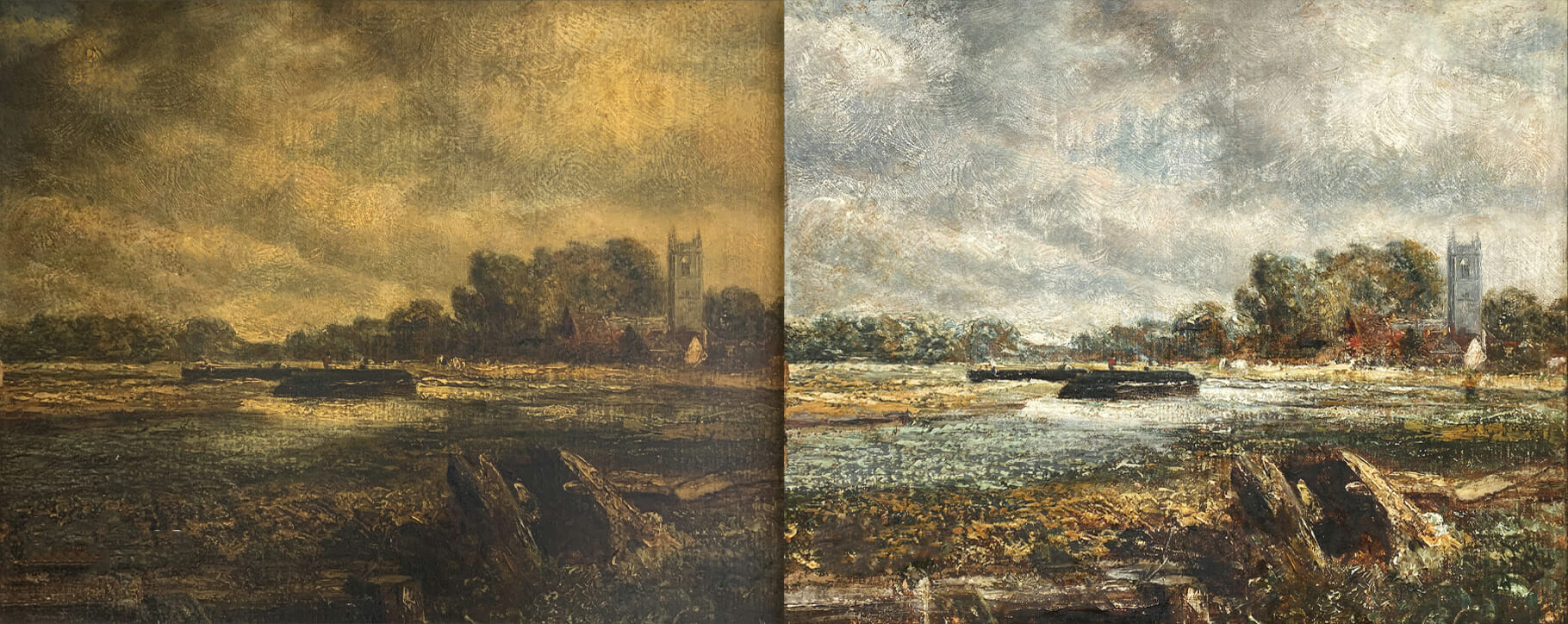 Above: a John Constable landscape before and after restoration in our studio – the surface was discoloured due to old varnish and smoke/nicotine staining
Above: a John Constable landscape before and after restoration in our studio – the surface was discoloured due to old varnish and smoke/nicotine staining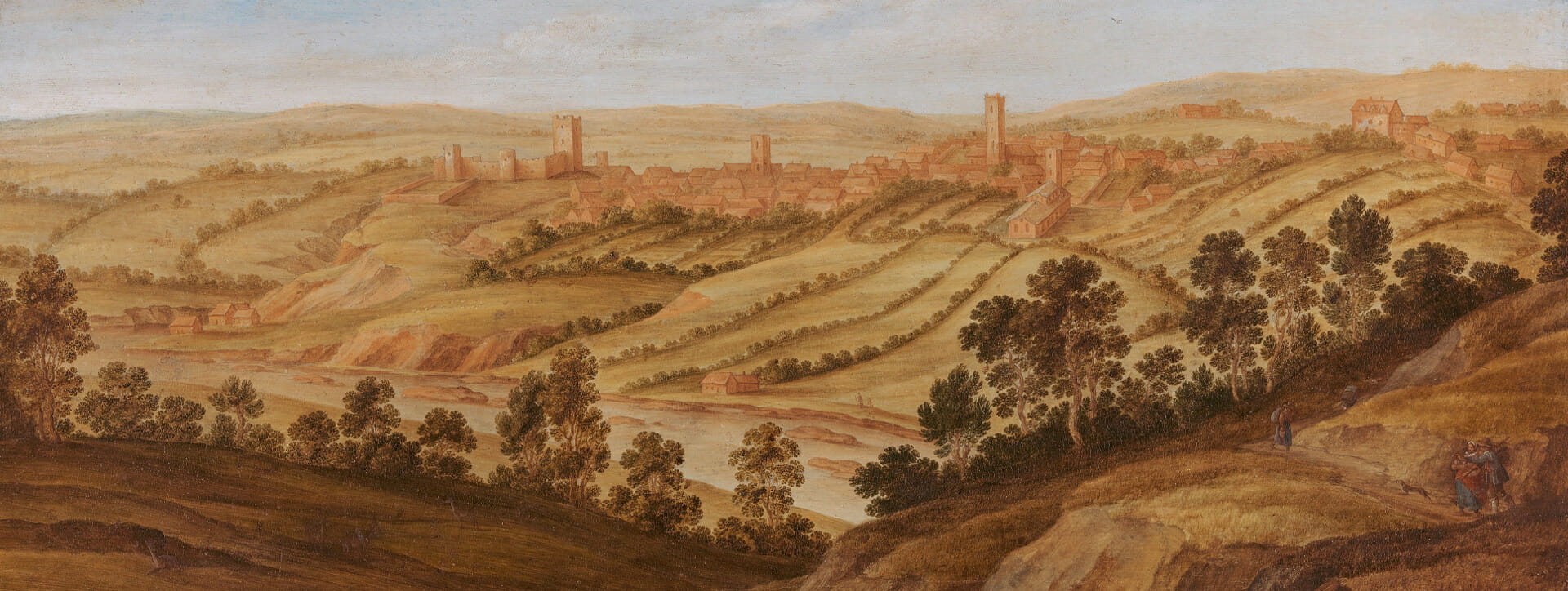 Above: a 17th century view of Richmond Castle, Yorkshire by Alexander Keirincx, 1639
Above: a 17th century view of Richmond Castle, Yorkshire by Alexander Keirincx, 1639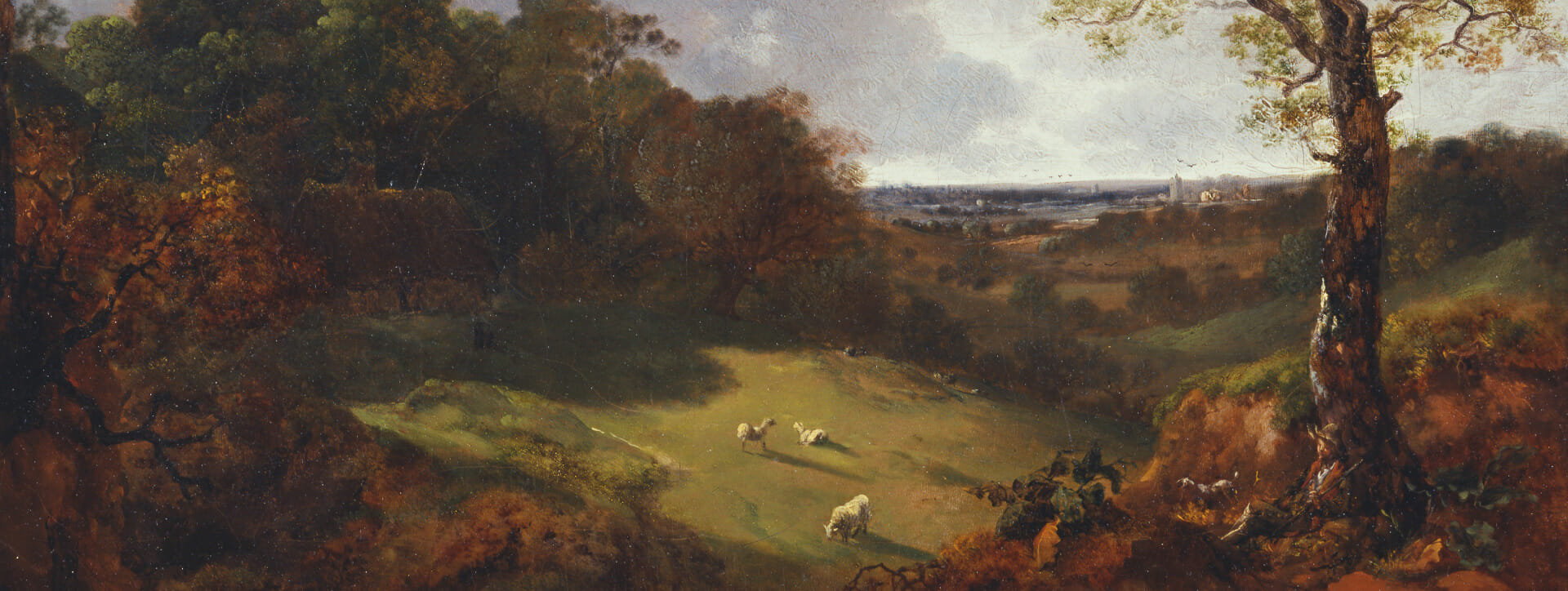 Above: detail from a landscape by Thomas Gainsborough dated to the mid 18th century
Above: detail from a landscape by Thomas Gainsborough dated to the mid 18th century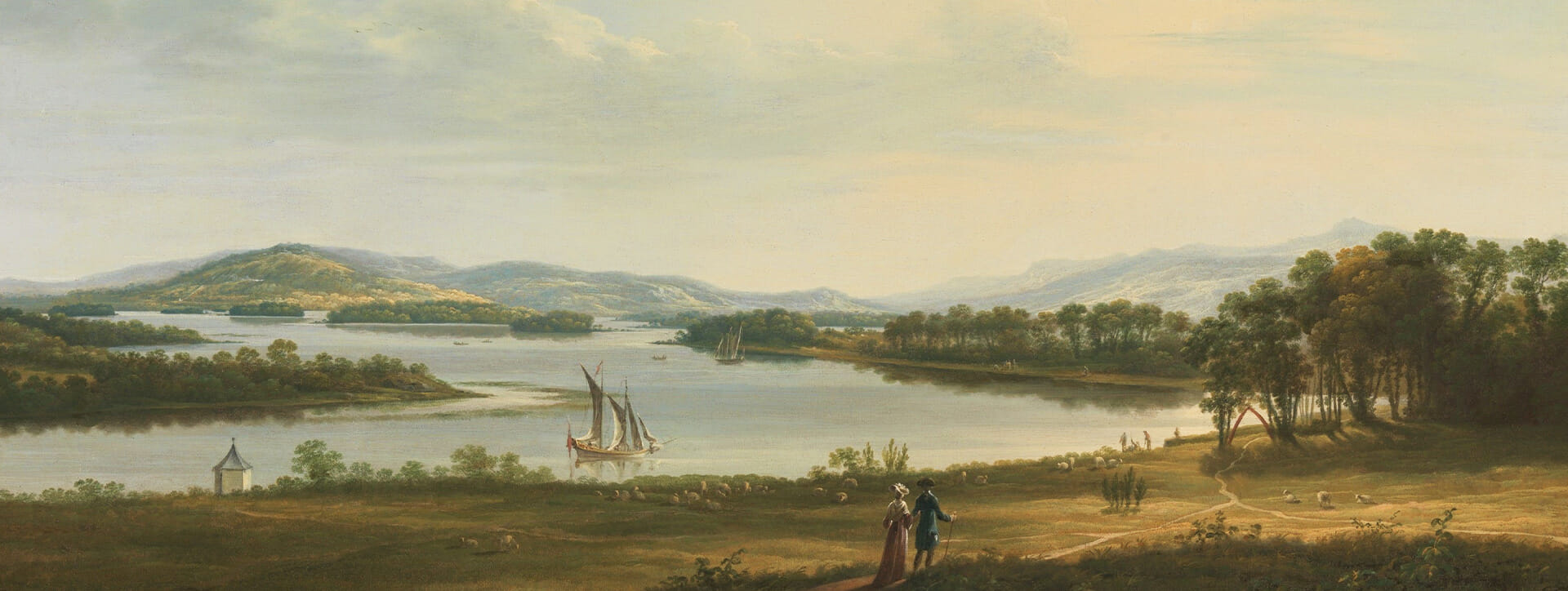 Above: a detail from a painting of Knock Ninney and Lough Erne from Bellisle, County Fermanagh, Ireland by Thomas Roberts, 1771
Above: a detail from a painting of Knock Ninney and Lough Erne from Bellisle, County Fermanagh, Ireland by Thomas Roberts, 1771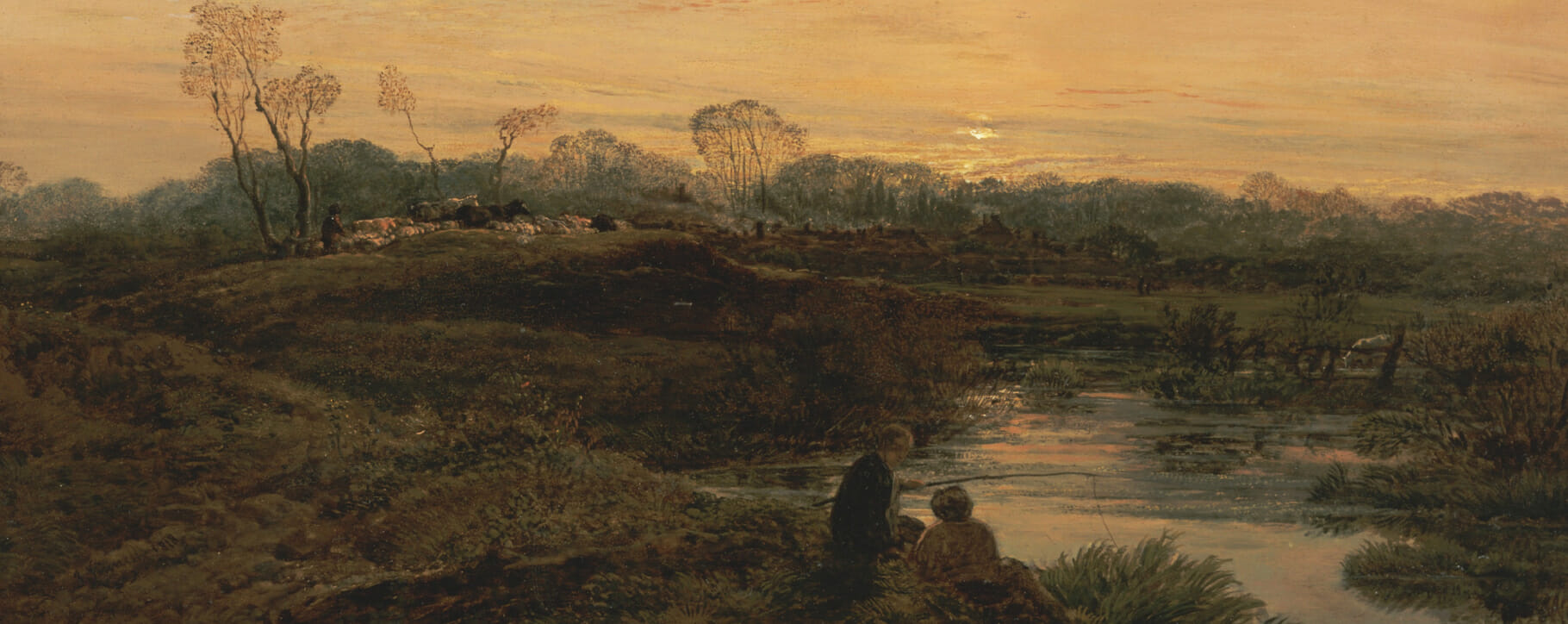 Above: a detail from a John Linnell landscape entitled Evening, Bayswater, 1818
Above: a detail from a John Linnell landscape entitled Evening, Bayswater, 1818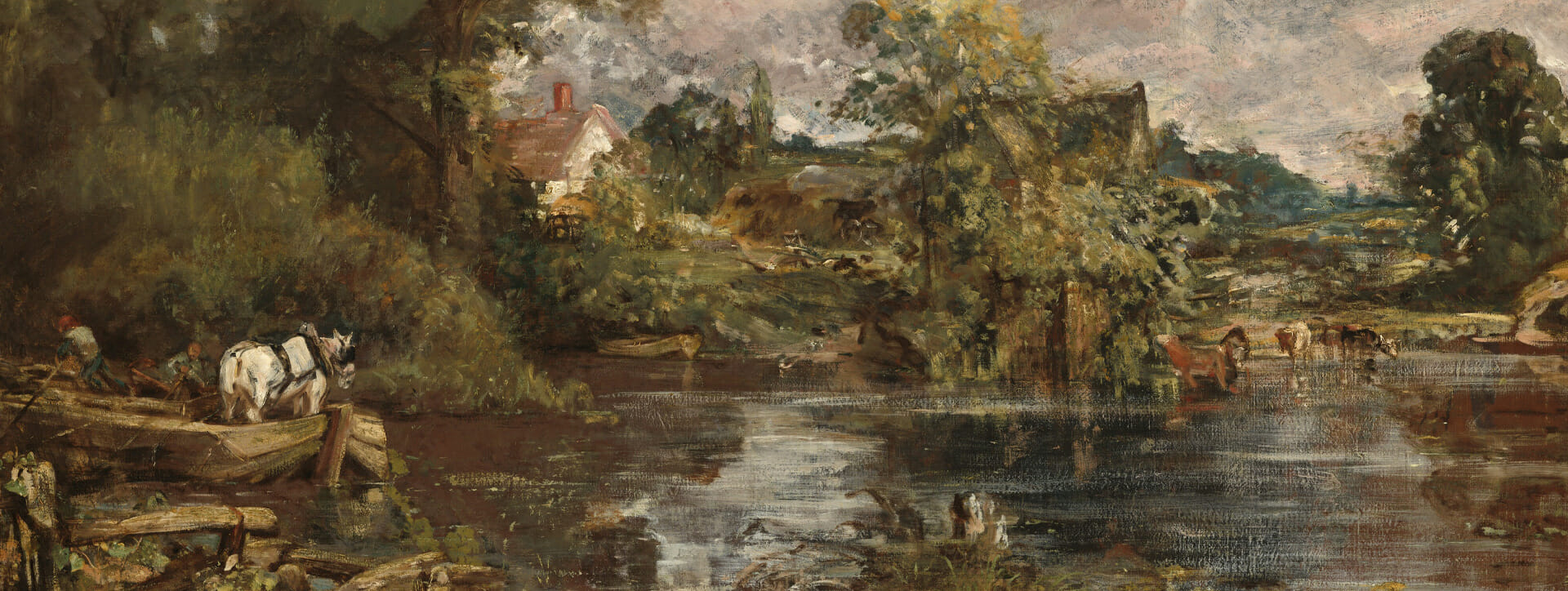 Above: a detail from an oil sketch by John Constable of his White Horse masterpiece, 1819
Above: a detail from an oil sketch by John Constable of his White Horse masterpiece, 1819 Above: a detail from a view of London from Greenwich Hill by Henry Dawson, 1869
Above: a detail from a view of London from Greenwich Hill by Henry Dawson, 1869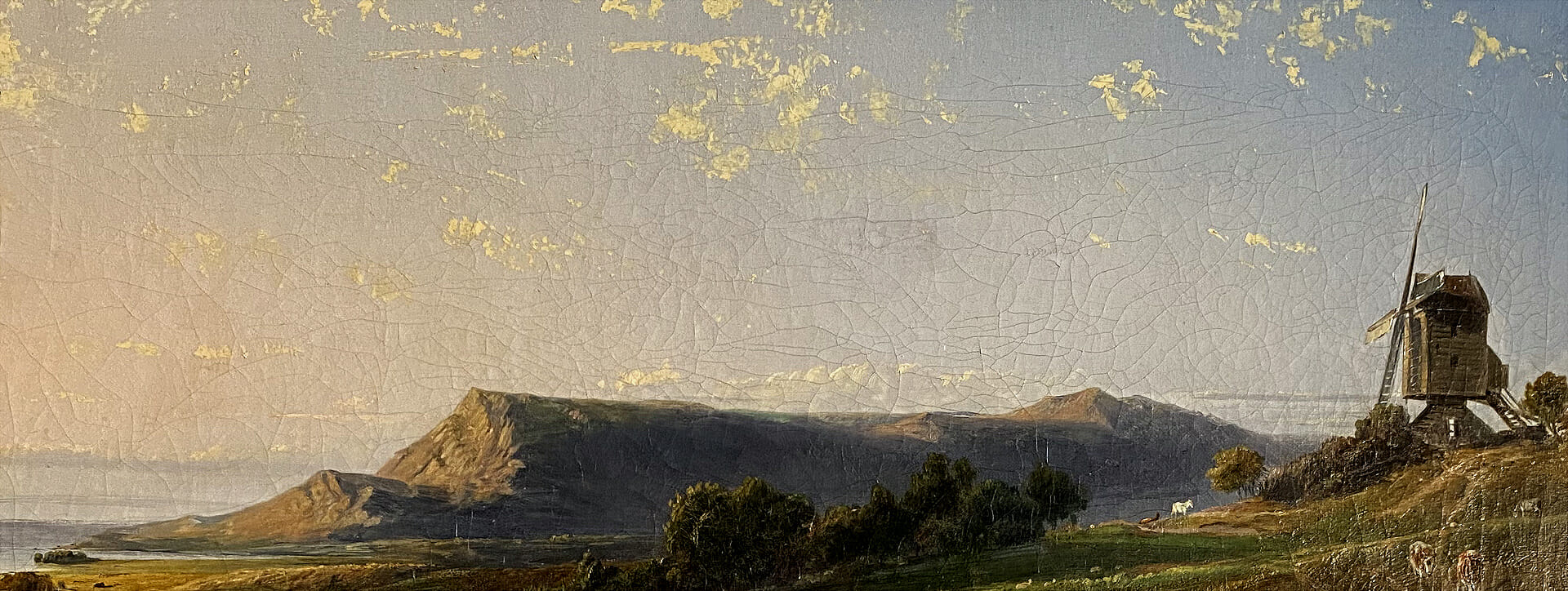 Above: detail from a landscape in our studio with a cracked surface, before restoration to stabilise the painting and lessen the disturbance
Above: detail from a landscape in our studio with a cracked surface, before restoration to stabilise the painting and lessen the disturbance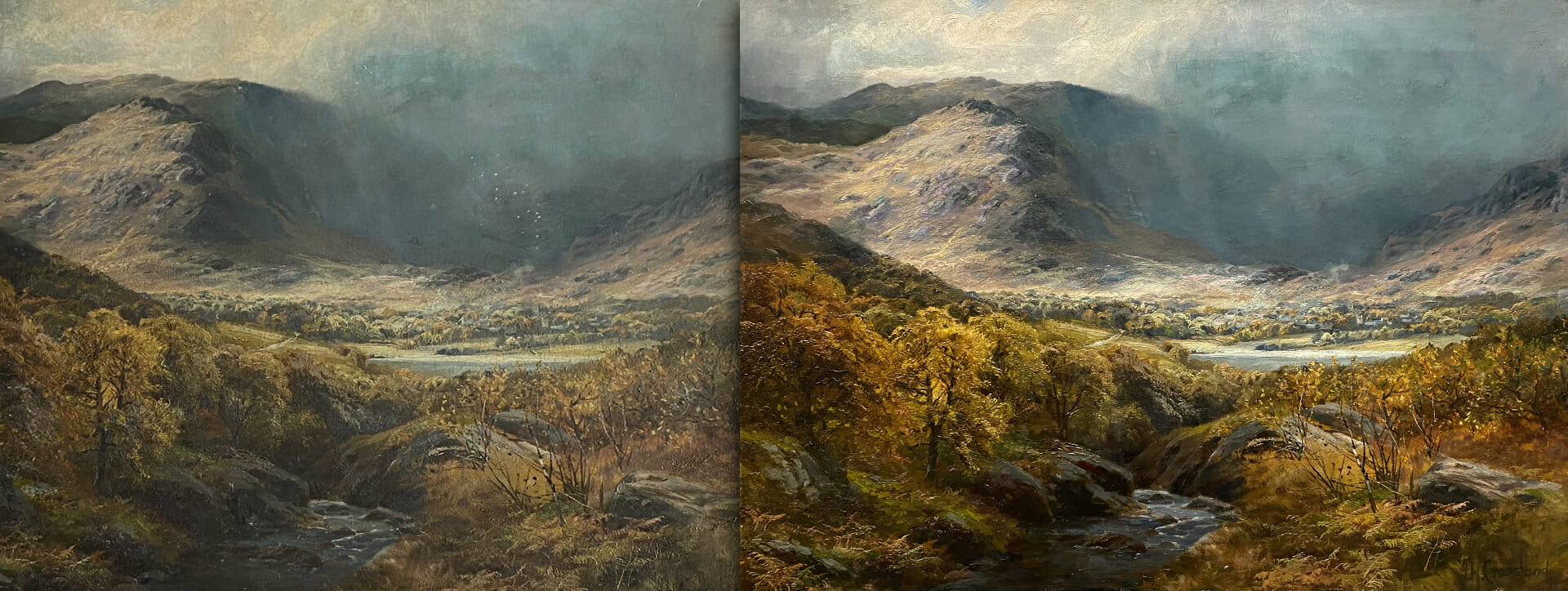 Above: a dull surface on a landscape caused by high humidity and dust in the atmosphere, as well as staining – before and after restoration by our team of conservators
Above: a dull surface on a landscape caused by high humidity and dust in the atmosphere, as well as staining – before and after restoration by our team of conservators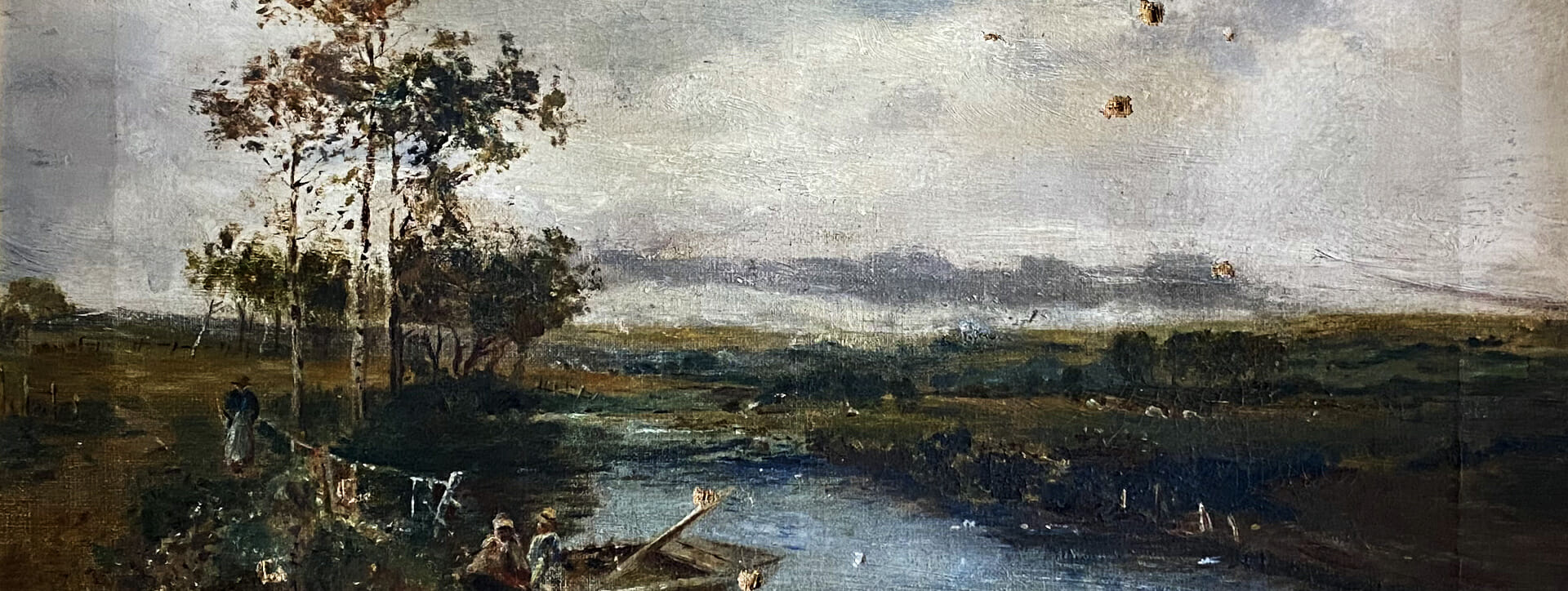 Above: a landscape painting with discolouration, puncture holes and a loose canvas in need of professional restoration
Above: a landscape painting with discolouration, puncture holes and a loose canvas in need of professional restoration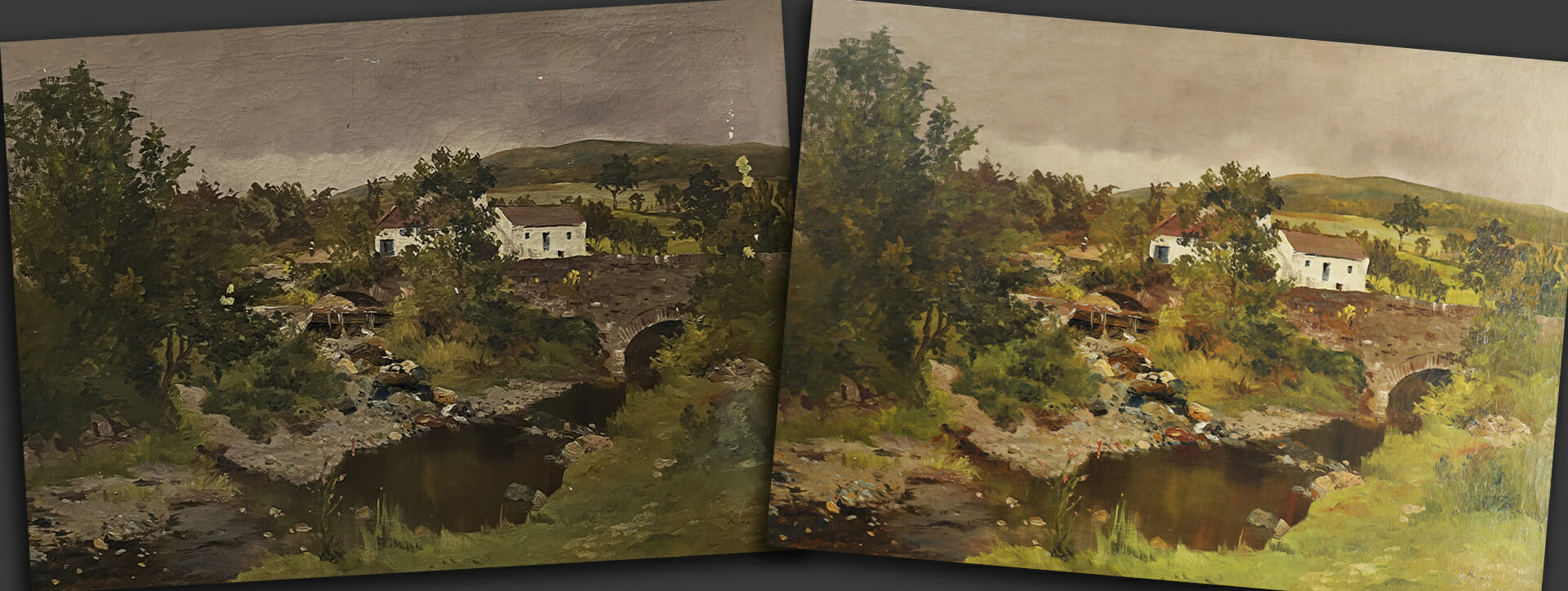 Above: a painting before and after treatments by our team, restoring a darkened surface and areas of cracking and staining
Above: a painting before and after treatments by our team, restoring a darkened surface and areas of cracking and staining 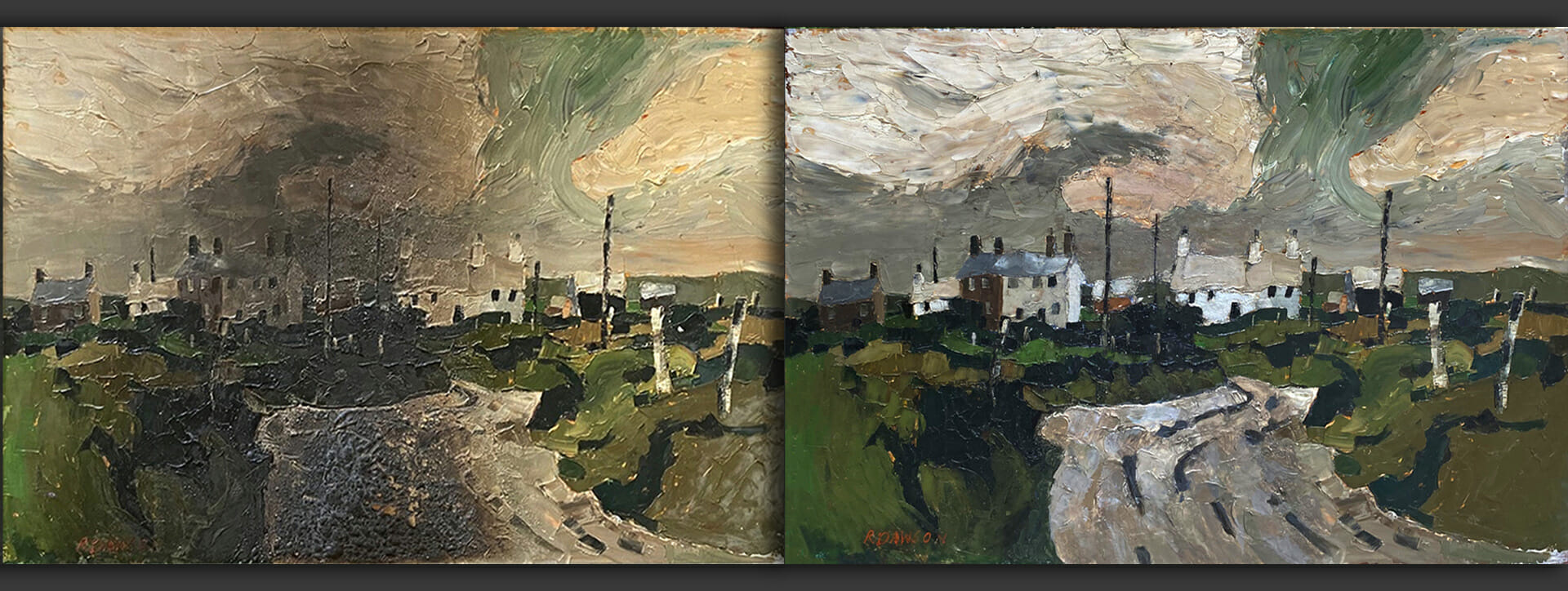 Above: a severely fire damaged landscape painting before and after restoration in our studio
Above: a severely fire damaged landscape painting before and after restoration in our studio Above: a torn landscape painting before and after restoration by our conservation team
Above: a torn landscape painting before and after restoration by our conservation team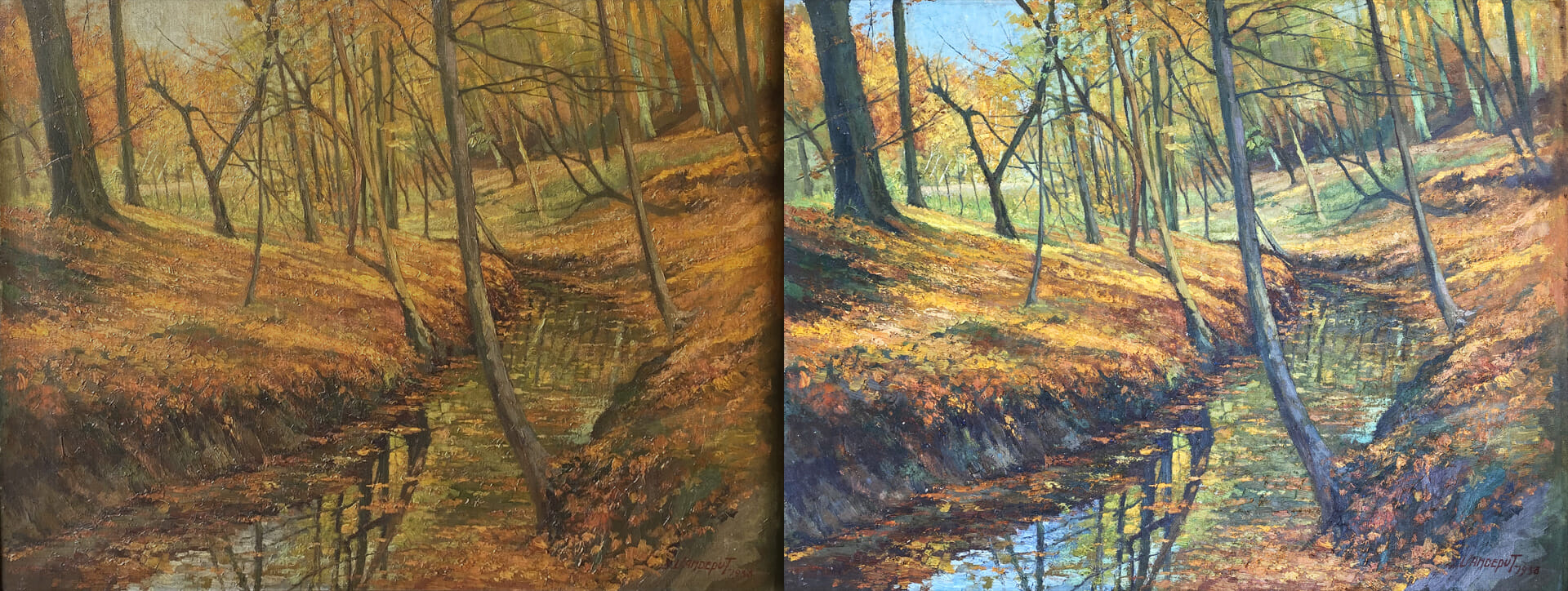 Above: a modern landscape before and after restoration due to nicotine staining
Above: a modern landscape before and after restoration due to nicotine staining 




